moimoi
AV Clubber  
Posts: 5,090 
|
Post by moimoi on Feb 28, 2016 17:26:40 GMT -5
Fragrant PlantsSpring is in the air--at least here in Chicago for a bit--so what better time to learn a bit about our favorite scents from nature? Per Wikipedia, perfumery existed in the Indus civilization (3300 BC – 1300 BC), where the earliest distillations of Ittar were mentioned in the Hindu Ayurvedic texts. The world's first-recorded chemist is a woman named Tapputi, a perfume maker mentioned in a cuneiform tablet from the 2nd millennium BC in Mesopotamia. She distilled flowers, oil, and calamus with other aromatics, then filtered and put them back in the still several times. The Persian chemist Ibn Sina (also known as Avicenna) introduced the process of extracting oils from flowers by means of distillation, the procedure most commonly used today. The art of perfumery prospered in Renaissance Italy, and in the 16th century the personal perfumer to Catherine de Medici, Rene the Florentine, took Italian refinements to France. Cultivation of flowers for their perfume essence, which had begun in the 14th century, grew into a major industry in the south of France.
Plants are by far the largest source of fragrant compounds used in perfumery. Plant-based aromatics are usually secondary metabolites produced as protection against herbivores, infections, as well as to attract pollinators. The sources of these compounds may be derived from various parts of a plant: bark (cinnamon), flowers and blossoms (tuberose), fruits (orange), leaves and twigs (lavender), resins (pine), roots/rhizomes/bulbs (ginger), seeds (anise), and woods (cedar). Some examples below:
Exhibit A: Genus Jasminum (Jasmine)
Origin: Jasmine is a genus of shrubs and vines in the olive family native to tropical and warm temperate regions of Eurasia, Australasia, and Oceania.
Features: Jasmines can be either deciduous (leaves falling in autumn) or evergreen (green all year round), and can be erect, spreading, or climbing shrubs and vines. The flowers are typically around 2.5 cm (0.98 in) in diameter. They are white or yellow in color, although in rare instances they can be slightly reddish. The fruits of jasmines are berries that turn black when ripe.
Fun Facts:
- The genus name is derived from the Persian yasameen ("gift from God")
- Jasmine-flower tea (茉莉花茶; pinyin: mò lì huā chá) is consumed in China, using Jasminum sambac flowers. The flowers and a base of green, white or oolong tea are "mated" in machines that control temperature and humidity. It takes four hours or so for the tea to absorb the fragrance and flavour of the jasmine blossoms, and for the highest grades, this process may be repeated as many as seven times.The spent flowers may or may not be removed from the final product, as the flowers are completely dry and contain no aroma. Giant fans are used to blow away and remove the petals from the denser tea leaves.
- The 1987 regime change in Tunisia and the Tunisian Revolution of 2011 are both called "Jasmine revolutions" in reference to the flower. Jasmine flowers were also used as a symbol during the 2011 Chinese pro-democracy protests in the People's Republic of China. In Syria, jasmine is the symbolic flower of Damascus, and in Thailand, jasmine flowers are a symbol for motherhood.
- A number of unrelated plants are known as 'jasmin' including jasmine rice, 'night blooming jasmine', Cape Jasmine (aka Gardenia), and Brazilian or Chilean Jasmine (aka Mandevilla).
 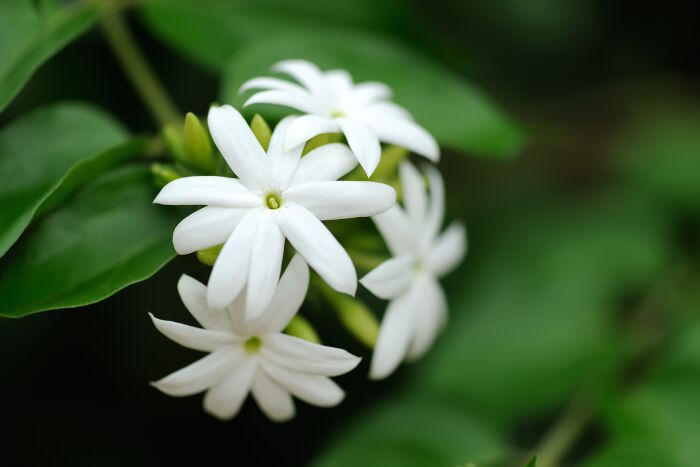

Exhibit B: Pogostemon cablin (patchouli)
Origin: native to tropical regions of Asia, and now extensively cultivated in China, South and Southeast Asia
Features: a bushy herb of the mint family, with erect stems, reaching two or three feet (about 0.75 metre) in height and bearing small, pale pink-white flowers
Fun Facts:
- During the 18th and 19th century, silk traders from China traveling to the Middle East packed their silk cloth with dried patchouli leaves to prevent moths from laying their eggs on the cloth. Many historians speculate that this association with opulent Eastern goods is why patchouli was considered by Europeans of that era to be a luxurious scent. It is said that patchouli was used in the linen chests of Queen Victoria.
- Both patchouli oil and incense underwent a surge in popularity in the 1960s and 1970s in the US and Europe, mainly as a result of the hippie movement.
- In 1985 Mattel used patchouli oil in the plastic used to produce the action figure Stinkor in the Masters of the Universe line of toys.

Exhibit C: Genus Boswellia (frankincense)
Origin: Arabia Peninsula, East Africa, India
Features: Frankincense is tapped from the scraggy but hardy trees by slashing the bark, which is called striping, and allowing the exuded resin to bleed out and harden. These hardened resins are called tears. There are several species and varieties of frankincense trees, each producing a slightly different type of resin. Boswellia sacra trees are considered unusual for their ability to grow in environments so unforgiving that they sometimes grow out of solid rock.
Fun Facts:
- The frankincense of the Jews, as well as of the Greeks and Romans, is also called Olibanum (from the Hebrew חלבנה). In Arabic, it is al-lubān (roughly translated: "that which results from milking"), a reference to the milky sap tapped from the Boswellia tree. Frankincense was reintroduced to Europe by Frankish Crusaders, although its name refers to its quality, not to the Franks themselves.
- A 2008 study reported that frankincense smoke was a psychoactive drug that relieves depression and anxiety in mice. The researchers found that the chemical compound Incensole Acetate was responsible for the effects. A 2012 study found "IA modulates the hypothalamic–pituitary–adrenal (HPA) axis and influences hippocampal gene expression, leading to beneficial behavioral effects supporting its potential as a novel treatment of depressive-like disorders."
- In a study published in 2009, it was reported that "Frankincense oil appears to distinguish cancerous from normal bladder cells and suppress cancer cell viability." In 2013, Leicester University researchers announced findings that AKBA (acetyl-11-keto-beta-boswellic acid), a chemical compound in the resin, has cancer-killing properties and has the potential to destroy ovarian cancer cells.



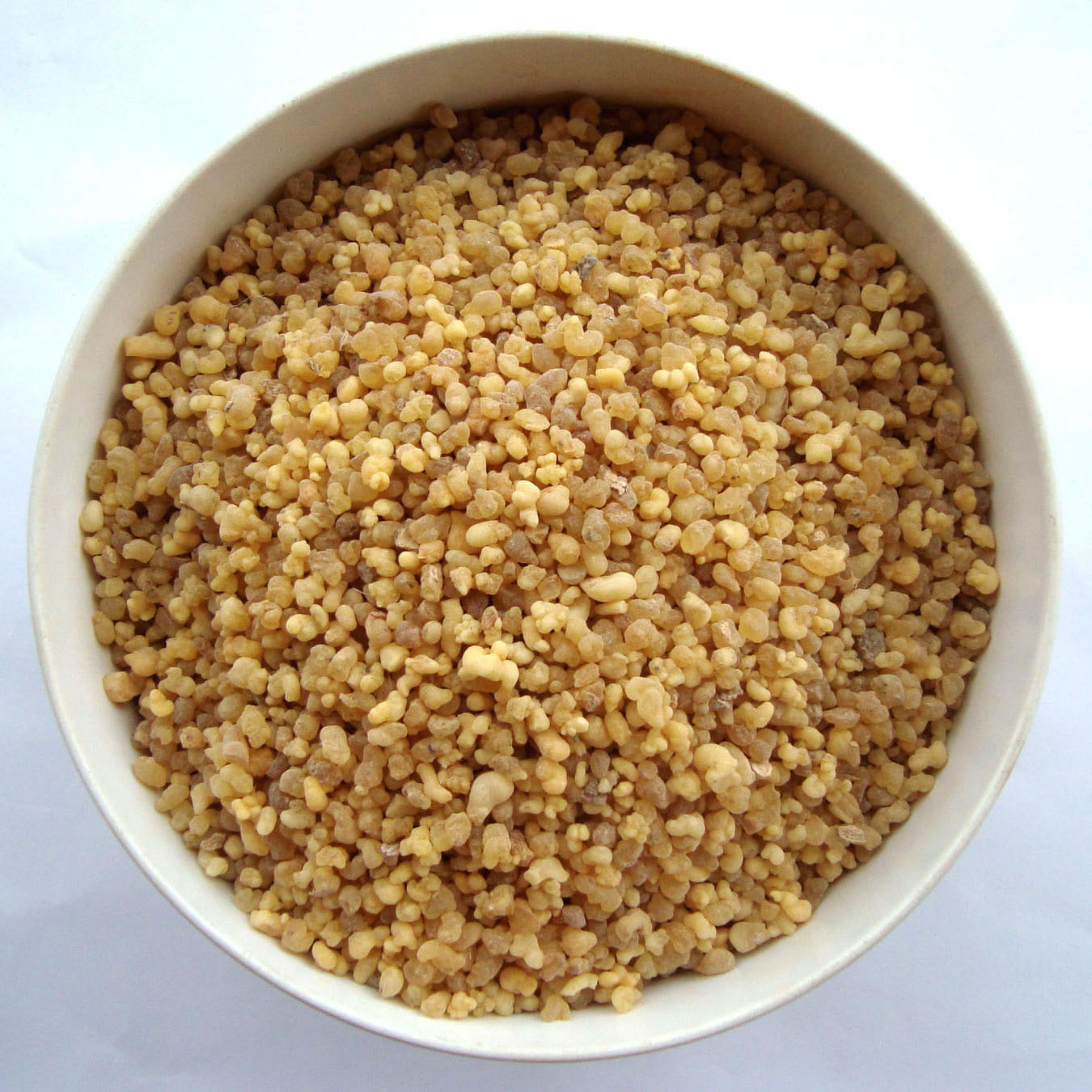
|
|
songstarliner
AV Clubber   i'm fine it's okay
i'm fine it's okay
Posts: 4,222  Member is Online
Member is Online
|
Post by songstarliner on Feb 28, 2016 17:49:07 GMT -5
Great stuff.
I love patchouli and have tried twice, unsuccessfully, to keep it as a houseplant. But dammit, I'm going to try again!
|
|
|
|
Post by Desert Dweller on Feb 29, 2016 0:32:10 GMT -5
Nice! Those trees are wild! I love those photos.
One of my friends here in the desert grows jasmine. It is quite lovely.
|
|
|
|
Post by Liz n Dicksgiving on Feb 29, 2016 11:55:43 GMT -5
Awesome post today! I had no idea that was how they made jasmine tea, and the fact that there was a patchouli-scented He-Man character is blowing my mind. But my favorite thing here is that picture of that Frankincense tree growing on that cliff! What the fuck? That's the craziest thing I've ever seen!
|
|
|
|
Post by haysoos on Feb 29, 2016 19:37:52 GMT -5
I never realized that frankincense was essentially pre-fossilized amber. I'm assuming that the tree is not very cold hardy, but those would make awesome boulevard trees. The crappy soil conditions along our streets wouldn't even be a problem!
|
|
moimoi
AV Clubber  
Posts: 5,090 
|
Post by moimoi on Mar 6, 2016 16:28:34 GMT -5
|
|
|
|
Post by haysoos on Mar 7, 2016 11:00:05 GMT -5
Now I'm sitting here trying to figure out if I want an erotic plant blog in my work browser history, and whether or not I can successfully claim it to be work related.
|
|
|
|
Post by Lord Lucan on Mar 7, 2016 11:39:43 GMT -5
This is a fascinating thread, moimoi.
|
|
moimoi
AV Clubber  
Posts: 5,090 
|
Post by moimoi on Mar 7, 2016 12:36:47 GMT -5
This is a fascinating thread, moimoi. Thanks! It's fun doing the research  |
|
|
|
Post by Jean-Luc Lemur on Mar 7, 2016 13:45:04 GMT -5
Now I'm sitting here trying to figure out if I want an erotic plant blog in my work browser history, and whether or not I can successfully claim it to be work related. The real question is whether you want to be the only one at work without an erotic plant blog in your browser history. |
|
|
|
Post by ganews on Mar 10, 2016 19:59:22 GMT -5
Just now getting around to linking to Wifemate's sketch of the titan arum at Denver Botanic Gardens. She did a whole series, one every day of the bloom cycle, but this is what's online. Now the Denver Botanic Gardens has posted a video of her sketching the corpse flower, and more of her sketches. |
|
moimoi
AV Clubber  
Posts: 5,090 
|
Post by moimoi on Mar 10, 2016 21:33:24 GMT -5
Very cool, ganews! Do you have any of her other sketches we could see? |
|
|
|
Post by ganews on Mar 10, 2016 21:37:19 GMT -5
Very cool, ganews! Do you have any of her other sketches we could see? Her website is linked in my signature, but it features more birds than plants. |
|
moimoi
AV Clubber  
Posts: 5,090 
|
Post by moimoi on Mar 10, 2016 21:48:17 GMT -5
Very cool, ganews! Do you have any of her other sketches we could see? Her website is linked in my signature, but it features more birds than plants. Cool! I may have to pick up the cardinals in winter hats for my holiday cards... |
|
moimoi
AV Clubber  
Posts: 5,090 
|
Post by moimoi on Mar 13, 2016 12:48:30 GMT -5
Foul PlantsLast night, as I pulled into my garage, I spotted a skunk rummaging around the trash cans in the alley. A harbinger of warmer weather? Sure, but also a signal that we're approaching the Ides of March, a bit of unpleasantness before we spring ahead. Having covered sweet-scented plants last time, we turn this week to the foul. Though the aforementioned titan arum is widely considered the worst-smelling plant on earth, here are a few other contenders: Exhibit A: Symplocarpus foetidus (Eastern skunk cabbage)Origin: wetlands of Eastern North America - native from Nova Scotia/southern Quebec to North Carolina and Tennessee. Features: Eastern skunk cabbage has large leaves, over 1' long and 1' wide. Only the early spring flowers are visible above the mud. The flowers are produced on a 2-5" long spadix contained within a 4-6" spathe (the phallic-looking thing in the center), tall and mottled purple in colour. The rhizome is often 1' thick. Fun Facts: - Eastern skunk cabbage is notable for its ability to generate temperatures of up to 15–35 °C (27–63 °F) above air temperature by cyanide resistant cellular respiration in order to melt its way through frozen ground, placing it among a small group of plants exhibiting thermogenesis. The higher internal temperature not only allows the flower to come up through snow-covered ground, but it may also help to attract pollinators by mimicking the heat released by a fresh corpse.
- Eastern skunk cabbage has roots which contract after growing into the earth. This pulls the stem of the plant deeper into the mud, so that the plant in effect grows downward, not upward. Each year, the plant grows deeper into the earth, so that older plants are practically impossible to dig up.
- In the 19th century the U.S. Pharmacopoeia listed eastern skunk cabbage as the drug "dracontium". It was used in the treatment of respiratory diseases, nervous disorders, rheumatism, and dropsy. Skunk cabbage was used extensively as a medicinal plant, seasoning, and magical talisman by various tribes of Native Americans.
skunk cabbage leaves growing along a brook in Martha's Vineyard

 skunk cabbage flower skunk cabbage flower
Exhibit B: Hydnora africana (Jackal food)
Origin: coast of southern Africa
Features: Per the internets: "This African flower smells like feces and looks like a scary vagina with sprouted fangs." Indeed, the plant grows underground, except for a fleshy flower that emerges above ground and emits an odor of dung and rot to attract its natural pollinators, dung beetles and carrion beetles. The flowers act as temporary traps, tricking the beetles with the scent and retaining those that enter long enough for them to pick up pollen.
Fun Facts:
- These plants do not have chlorophyll and do not perform photosynthesis. H. africana is a parasite that exists largely as a tangle of roots attached to the root system of Euphorbia plants.
- The genus name comes from the Greek word hydon, which translates to being like a fungus, and its discoverer, Swedish botanist Carl Thunberg, listed it as a fungus before later analysis revealed that it was, in fact, a flowering plant.
- The fruit grows underground, taking up to two years to ripen fully. It is similar in taste and texture to a potato. The fruits are small and packed full of tens of thousands of tiny seeds that taste quite nice. All sorts of mammals and birds are partial to them and all will spread the seeds far and wide, hopefully near a Euphorbia plant, deposited in a little parcel of dung. Part of traditional Khoi food, it is often thought to possess medicinal properties that help cure dysentery, kidney and bladder complaints, and acne. Among other uses, it is used for tanning and preserving fishnets because it is an astringent.
 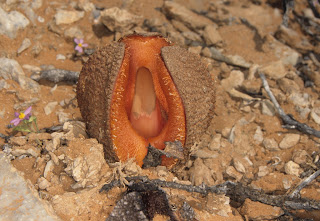
Exhibit C: Dracunculus vulgaris (Voodoo Lily, Snake Lily, Black Dragon)
Origin: the Balkans, extending as far as Greece, Crete, and the Aegean Islands, and also to the south-western parts of Anatolia
Features: The species is characterized by a large purple spathe and spadix, which has a very unpleasant smell reminiscent of rotting meat to attract flies as pollinators. The large palmate leaves have occasional cream flecks along the veins.
There are two sets of flowers, female at the bottom and male above; the topmost flowers are sterile and modified into a kind of thorn.
Fun Facts:
- It is believed that carrying the roots or leaves protects against vipers and serpents. It may have been carried on boats to repel sea serpents. One website advises, "if you wash your hands in a liquor made from the plant you can handle snakes with impunity."
- The good news is that the smell doesn't last too long — only about a day — and the flower itself is stunning and unique. That's one of the reasons it has been introduced to the United States, most commonly on the West Coast in California, Oregon and Washington.
- No hothouse flower, the plant is a rather robust and solitary (seldom a clump-forming) herb, sometimes up to 2 m high. It prefers fertile moist soil and can be found in undisturbed olive groves and waste land.
 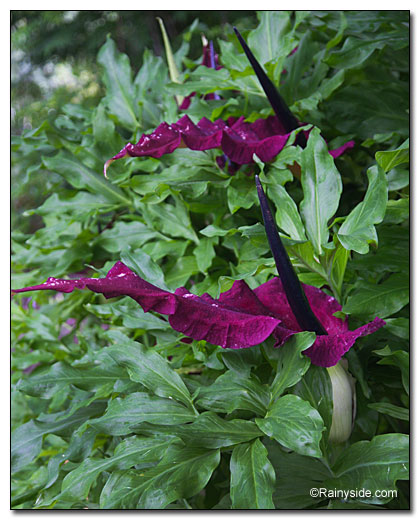 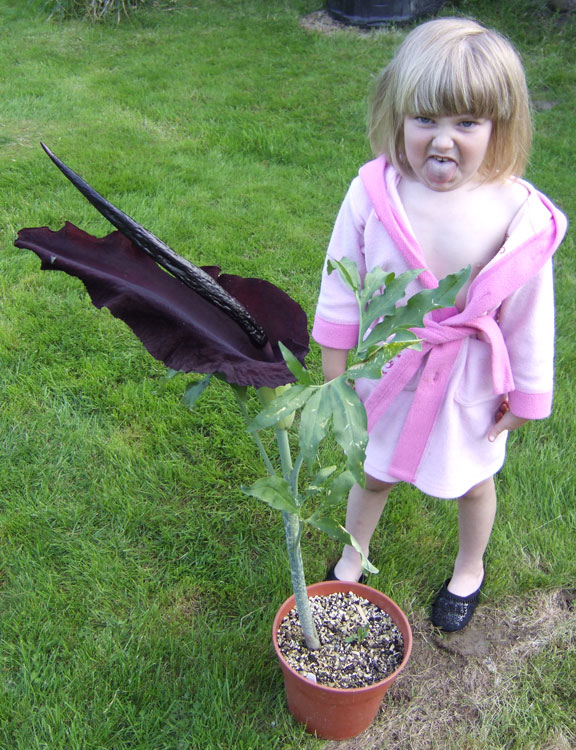
|
|
|
|
Post by haysoos on Mar 15, 2016 15:23:40 GMT -5
It's like the voodoo lily is specifically trying to be the gothiest plant ever grown.
|
|
songstarliner
AV Clubber   i'm fine it's okay
i'm fine it's okay
Posts: 4,222  Member is Online
Member is Online
|
Post by songstarliner on Mar 15, 2016 22:25:33 GMT -5
Another great post! The vagina dentata plant made me laugh out loud, as did that last pic with the little girl. How are these real plants?? Life on Earth is amazing and I'm glad I'm here to see it.
|
|
|
|
Post by Jean-Luc Lemur on Mar 17, 2016 15:06:27 GMT -5
As someone who just had to pass up a chance to go to Namibia I have to say that Hydnora is fascinating (as is the below-ground biogeochemistry of southern Africa—lots of stuff mostly grows underground there, and roots are very important for global carbon storage).
Also, I’m guessing that all plants are erotic plants, it’s just that they get more and more niche and fetishistic in terms of their appeal.
|
|
moimoi
AV Clubber  
Posts: 5,090 
|
Post by moimoi on Mar 17, 2016 18:04:20 GMT -5
Also, I’m guessing that all plants are erotic plants, it’s just that they get more and more niche and fetishistic in terms of their appeal. I would posit that plants in general are sexy (in that they reproduce sexually and therefore have biomarkers of 'sexiness'). They appeal to all five senses (if you count wind rustling through the trees) and it's easy to develop certain fetishistic attachment to them. Like some people are crazy about roses. Or organic veggies. I admit, I'm kind of obsessed with my hydrangea bush that can bloom pink, purple, and blue at the same time by manipulating the soil PH. |
|
|
|
Post by ganews on Mar 17, 2016 21:54:44 GMT -5
Also, I’m guessing that all plants are erotic plants, it’s just that they get more and more niche and fetishistic in terms of their appeal. I would posit that plants in general are sexy (in that they reproduce sexually and therefore have biomarkers of 'sexiness'). They appeal to all five senses (if you count wind rustling through the trees) and it's easy to develop certain fetishistic attachment to them. Like some people are crazy about roses. Or organic veggies. I admit, I'm kind of obsessed with my hydrangea bush that can bloom pink, purple, and blue at the same time by manipulating the soil PH. Well, plenty of non-flowering plants can reproduce asexually as well. Side note: in my house, when we hear someone state that they are "asexual" (either in personal orientation or as a misnomer for "celibate"), we laugh and say that they should grow a bud. Like Bruce Campbell in Army of Darkness. There ought to be a better term. |
|
moimoi
AV Clubber  
Posts: 5,090 
|
Post by moimoi on Mar 20, 2016 21:27:49 GMT -5
Before moving on from the topic of plant scent, here's a nice abstract of a recent article in Lucky Peach (for those of you with online access):
Smells like green spirit, Chemical warfare, distress signals, death, and deliciousness: Plants smells we shouldn’t like, but do
The sense of smell is a critical component of taste in consuming food. Plants emit odors that humans take in as flavors and aromas. However, what most people perceive as sweet, sour, bitter, salty and umami, plants on the other hand release these smells as defense mechanisms to protect themselves. Without a sense of smell, the human ability to experience flavor would be muted and bland. A variety of volatile compounds attribute to the perceived smells in foods.
These lightweight compounds diffuse through the air and are distinguished by humans and other organisms as messages. Volatiles found in plants can be used for advantageous purposes to alert other plants of danger. The smell commonly found in chopped salads contain molecules called green-leaf volatiles that communicate with other nearby plants that cells are needed to heal and act as a distress call. In root plants like wasabi and horseradish, chemical aroma compounds are not necessarily created in the plant itself but are emitted when the plant is damaged. Enzymatic reactions create the volatiles from a storage of nonvolatile compounds. Another common aromatic compound commonly found in herbs and spice is a category called terpenoids which contains compounds that are used as insecticides, drought-protection, antibacterial components, and anti-grazing deterrents. Compounds found in the terpene family include limonene, citral, camphor, terpenoid 1,8-cineole, and thujone which in high concentration can cause excitation, convulsions, and brain damage but in plants, protect them from the risk of droughts.
These highly aromatic volatile compounds are often overlooked but play a critical role not only in food but also in nature and in the agriculture industry. A review of these compounds and their associated compounds remind the public that these aromas are more than just smells but a significant contributor to flavor complexity and plant productivity.
Johnson A. 2015. Smells like green spirit, Chemical warfare, distress signals, death, and deliciousness: Plants smells we shouldn’t like, but do. Lucky Peach. 15: 6-8.
|
|
moimoi
AV Clubber  
Posts: 5,090 
|
Post by moimoi on Mar 27, 2016 13:28:10 GMT -5
Ephemeral Plantsさすが花ちるにみれんはなかりけり sasuga hana chiru ni miren wa nakari keri
when cherry blossoms scatter...no regrets - Kobayashi Issa Though not a true ‘ephemeral’ cherry blossoms and other short-lived plants are some of the most inspiring in nature. Per Wikipedia: "An ephemeral plant is one marked by short life cycles. Several growth strategies can be classified as ephemeral. Spring ephemeral refers to perennial plants that emerge quickly in the spring and die back to their underground parts after a short growth and reproduction phase. Desert ephemerals are plants that are adapted to take advantage of the short wet periods in arid climates and “mud-flat annuals” take advantage of short periods of low water. In areas subjected to recurring human disturbance, such as plowing, weedy ephemerals are very short lived plants whose entire life cycle takes less than a growing season. In each case, the species has a life cycle timed to exploit a short period when resources are freely available."
Exhibit A: Ficaria verna (Fig Buttercup or Lesser Celandine)
Origin: native to Europe and West Asia; classified as an invasive species or noxious weed in North America and the UK Features: The plant features fleshy dark green, heart-shaped leaves and distinctive flowers with bright yellow, glossy petals. Flowering from March through May, its appearance across the landscape is regarded by many as a harbinger of spring. Fun Facts:
- The poet William Wordsworth was very fond of the flower and it inspired him to write three poems, including the following from his ode to the celandine:
"I have seen thee, high and low / Thirty years or more, and yet/ T'was a face I did not know." Upon Wordsworth's death, it was proposed that a celandine be carved on his memorial plaque inside St Oswald's Church, Grasmere, but unfortunately the greater celandine Chelidonium majus was mistakenly used. - The flower also inspired Edward Thomas and C.S. Lewis, who featured celandine in a key passage from The Lion, the Witch, and the Wardrobe. D. H. Lawrence mentions celandine frequently in Sons and Lovers. They appear to be a favorite of the protagonist, Paul Morrel.
- The plant is known as pilewort by some herbalists because it has historically been used to treat piles (hemorrhoids). Lesser celandine is still recommended in several "current" herbal guides for treatment of hemorrhoids by applying an ointment of raw leaves as a cream or lanolin to the affected area. Supposedly, the knobby tubers of the plant resemble piles, and according to the doctrine of signatures this resemblance suggests that pilewort could be used to cure piles. Note, however, the plant is poisonous if ingested raw and potentially fatal to grazing animals and livestock such as horses, cattle, and sheep.
 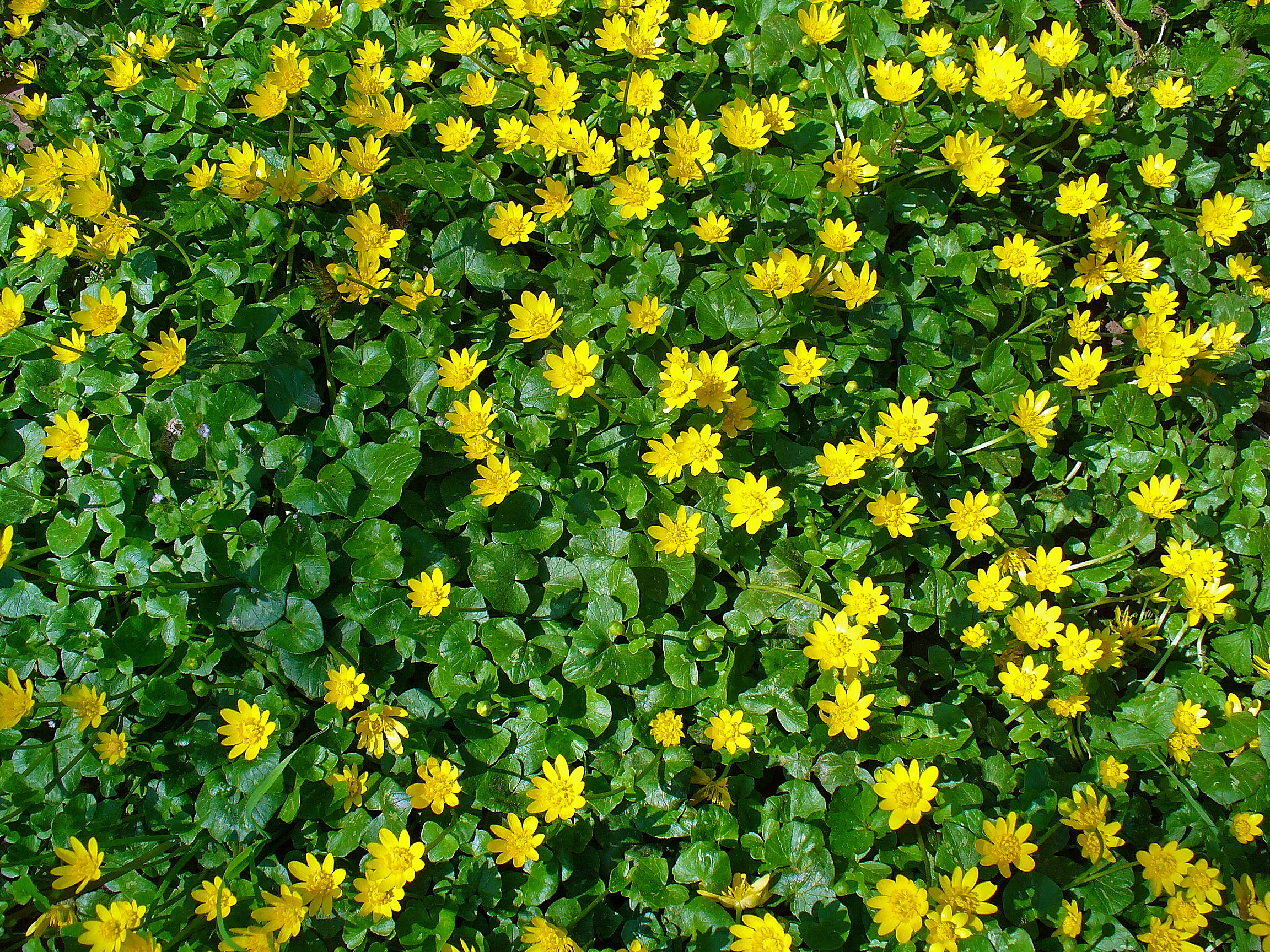 Exhibit B: Arabidopsis thaliana (Arabidopsis, Mouse-ear Cress) Exhibit B: Arabidopsis thaliana (Arabidopsis, Mouse-ear Cress)
Origin: They are native to Europe, Asia, and Northwest Africa, usually found by roadsides or disturbed land. There are over 750 natural varieties of A. thaliana, with variation among different environments that suggest all strains have a common ancestor and have evolved over time. Features: Usually growing to 20–25 cm tall, the leaves form a rosette at the base of the plant, with a few leaves also on the flowering stem. The flowers are 3 mm in diameter and the fruit is a capsule 5–20 mm long, containing 20–30 seeds. Roots are simple in structure, with a single primary root that grows vertically downward, later producing smaller lateral roots. The central stem that produces flowers grows after about three weeks and the flowers naturally self-pollinate. Fun Facts:
- A winter annual with a life cycle of just six weeks, Arabidopsis is a popular model organism in plant biology and genetics. It was long thought to have the smallest genome of all flowering plants and was the first plant to have its genome sequenced. It is a popular tool for understanding the molecular biology of many plant traits, including flower development and light sensing.
- The start of the Arabidopsis research community dates to a newsletter called Arabidopsis Information Service (AIS), established in 1964. The first International Arabidopsis Conference was held in 1965, in Göttingen, Germany. In 2016, it was named as one of the organisms that would be involved in CRISPR-based genetic engineering. Ongoing research on Arabidopsis thaliana is being performed on the International Space Station by the European Space Agency. The goals are to study the growth and reproduction of plants from seed to seed in microgravity.
- A. thaliana is edible by humans and, as with other mustard greens, is used in salads or sautéed.
  Scanning electron micrograph of atrichome, a leaf hair of Arabidopsis thaliana, a unique structure that is made of a single cell
Exhibit C: Sanguinaria canadensis (Bloodroot, Tetterwort, Red Puccoon)
Origin: Native to eastern North America, it is the only species in the genus Sanguinaria, included in the family Papaveraceae (poppy). Features: Typically rises 6-10" tall and spreads over time in the wild to form large colonies on the forest floor. Each flower stalk typically emerges in spring wrapped by one palmate, deeply-scalloped, grayish-green, basal leaf. As the flower blooms, the leaf unfurls. Each flower stalk produces a solitary, 2" wide, 8-10 petaled white flower with numerous yellow center stamens. Flowers open up in sun but close at night, and are very short-lived (1-2 days). Leaves continue to grow in size after bloom (sometimes to as much as 9" across) and remain attractive until mid to late summer when the plant goes dormant. All parts of the plant exude a bright reddish-orange sap when cut, hence the common name. The double-flowered forms are prized by gardeners for their large showy white flowers, which are produced very early in the gardening season and bloom much longer than the normal forms. Fun Facts:
- Bloodroot is a popular red natural dye used by Native American artists, especially among southeastern river cane basketmakers. A break in the surface of the plant, especially the roots, reveals a reddish sap which can be used as a dye.
- Sanguinarine kills animal cells by blocking the action of Na+/K+-ATPase transmembrane proteins. As a result, applying bloodroot to the skin may destroy tissue and lead to the formation of a large scab, called an eschar. Applying escharotic agents, including bloodroot, to the skin is sometimes suggested as a home treatment for skin cancer, but these attempts can be severely disfiguring. Bloodroot extracts have also been promoted by supplement companies as a treatment or cure for cancer. The U.S. Food and Drug Administration has listed some of these products among its "187 Fake Cancer 'Cures' Consumers Should Avoid".
- Commercial uses of sanguinarine and bloodroot extract include dental hygiene products. The United States FDA has approved the inclusion of sanguinarine in toothpastes as an antibacterial or anti-plaque agent.However, the use of sanguinaria in oral hygiene products is associated with the development of a premalignant oral leukoplakia, which may develop into oral cancer. On 24 Nov 2003, the Colgate-Palmolive Company commented by memorandum to the FDA that then-proposed rules for levels of sanguinarine in mouthwash and dental wash products were lower than necessary. However, this conclusion is controversial.
   Exhibit D: Galanthus (Snowdrop) Exhibit D: Galanthus (Snowdrop)
Origin: The genus Galanthus is native to Europe and the Middle East, from Spain, France and Germany in the west through to Iran in the east. It has become naturalized in other parts of Europe (Norway, Sweden, Great Britain, Belgium and the Netherlands) as well as in eastern Canada and the United States. Features: All species of Galanthus are perennial, herbaceous plants which grow from bulbs. Each bulb generally produces just two or three linear leaves and an erect, leafless scape (flowering stalk), which bears at the top a pair of bract-like spathe valves joined by a papery membrane. From between them emerges a solitary, pendulous, bell-shaped white flower, held on a slender pedicel. The flower has no petals; it consists of six tepals, the outer three being larger and more convex than the inner series. Most flower in winter, before the vernal equinox (20 or 21 March in the Northern Hemisphere), but certain species flower in early spring and late autumn. Fun Facts:- Celebrated as a sign of spring, snowdrops can form impressive carpets of white in areas where they are native or have been naturalized. These displays may attract large numbers of sightseers. There are a number of snowdrop gardens in England, Wales, Scotland and Ireland. Several gardens open specially in February for visitors to admire the flowers. An international community of “Galanthophiles” trade cultivars and due to some species being threatened in the wild, it is now illegal to collect bulbs in most countries.
- It was suggested by Andreas Plaitakis and Roger Duvoisin in 1983 that the mysterious magical herb "moly" that appears in Homer's Odyssey is actually snowdrop. An active substance in snowdrop is called galantamine, which, as Acetylcholinesterase inhibitor, could have acted as an antidote to Circe's poisons. Other literary uses of snowdrops include the fairytale play The Twelve Months by Russian writer Samuil Marshak, the poem The Snowdrop by Lord Alfred Tennyson, the short story The Snowdrop by Hans Christian Andersen, and the 2007 film Stardust.
- In 1995, snowdrops were involved the “Pusztai affair”, in one of the first major controversies related to genetically modified food. They contain an active lectin or agglutinin named GNA (Galanthus nivalis agglutinin), which was used to genetically modify potatoes. The scientist, Árpád Pusztai, said in a radio interview and in a Lancet article that his group had observed damage to the intestines and immune systems of rats fed the genetically modified potatoes. He also said "If I had the choice I would certainly not eat it", and that "I find it's very unfair to use our fellow citizens as guinea pigs".
- "Snowdrops" was the nickname that the British people gave during the Second World War to the military police of the United States Army (who were stationed in the UK preparatory to the invasion of the continent) because they wore a white helmet, gloves, gaiters, and Sam Browne belt against their olive drab uniform.


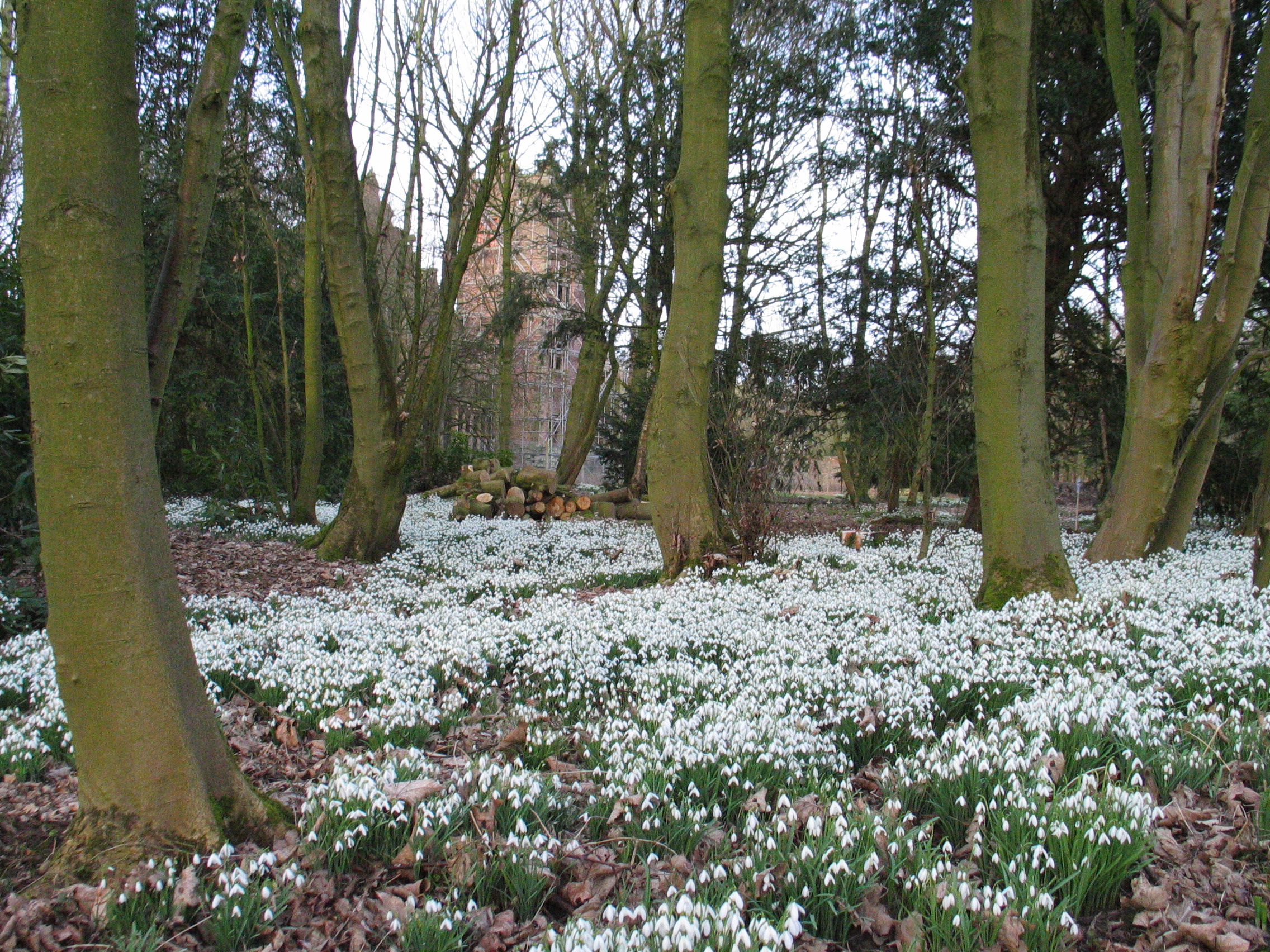 
|
|
|
|
Post by Lord Lucan on Mar 28, 2016 15:36:26 GMT -5
Are cherry blossoms as plentiful in Japan as I imagine? I appreciate the literary references. I actually have a list of of the plants Lawrence mentions in his novels and poetry.
|
|
moimoi
AV Clubber  
Posts: 5,090 
|
Post by moimoi on Mar 28, 2016 16:04:42 GMT -5
Are cherry blossoms as plentiful in Japan as I imagine? I appreciate the literary references. I actually have a list of of the plants Lawrence mentions in his novels and poetry. Oh yeah, cherry blossom viewing in springtime and watching leaves change color in fall are like major holidays in Japan: en.wikipedia.org/wiki/Hanamien.wikipedia.org/wiki/Leaf_peeping |
|
|
|
Post by Lord Lucan on Mar 28, 2016 16:13:22 GMT -5
Are cherry blossoms as plentiful in Japan as I imagine? I appreciate the literary references. I actually have a list of of the plants Lawrence mentions in his novels and poetry. Oh yeah, cherry blossom viewing in springtime and watching leaves change color in fall are like major holidays in Japan: en.wikipedia.org/wiki/Hanamien.wikipedia.org/wiki/Leaf_peepingI didn't know about Hanami; that's lovely. I think I'd like Japan generally. |
|
songstarliner
AV Clubber   i'm fine it's okay
i'm fine it's okay
Posts: 4,222  Member is Online
Member is Online
|
Post by songstarliner on Mar 28, 2016 18:47:41 GMT -5
Beautiful. Bloodroot grows abundantly in my area, and I always love to see it - the flowers are lovely of course, but the leaves are gorgeous too - one beautiful leaf unfurling around the blossom  It's one of the early-blooming wildflowers, and you can often find huge thickets of blossoms in the forest while the undergrowth is relatively sparse. And of course I get all excited because bloodroot blooming means one step closer to morels! MORELS ARE COMING AND I WILL FIND THEM. In our area it goes (generally, with some overlapping and variation due to rain, temp etc) coltsfoot -> spring beauties -> bloodroot -> mayapple leaves -> violets -> MORELS MORELS MORELS |
|
repulsionist
TI Forumite
 actively disinterested
actively disinterested
Posts: 3,687 
|
Post by repulsionist on Mar 28, 2016 20:15:09 GMT -5
songstarliner, I won't tell you how easy Morels are in Western Washington. My first go with my pal, his Dad, and me netted me a 1.5lb haul.
|
|
songstarliner
AV Clubber   i'm fine it's okay
i'm fine it's okay
Posts: 4,222  Member is Online
Member is Online
|
Post by songstarliner on Mar 28, 2016 20:23:07 GMT -5
songstarliner, I won't tell you how easy Morels are in Western Washington. My first go with my pal, his Dad, and me netted me a 1.5lb haul. Way to brag, bragger  Feh, who'd want to clean that many morels? I bet you ate so many bugs. Here they come and go in waves - you'll have a crazy year where they're everywhere, even in the gravel of your driveway, and then the next year, nothing. Our best year ever we found about 4 pounds in one afternoon and stopped to buy a dehydrator on the way home. |
|
moimoi
AV Clubber  
Posts: 5,090 
|
Post by moimoi on Apr 10, 2016 19:18:03 GMT -5
Living Fossils
From the ephemeral we turn to the unchanging and eternal*. There is no formal definition of a ‘living fossil’ – it’s not a scientific term per se – but many scientists have observed ancient species that: 1) have not gone extinct; 2) have not produced, or "radiated," many new species (i.e. low taxonomic diversity); and 3) have remained relatively unchanged over the course of millennia. These living fossils offer insight into plant, animal, and human evolution. *if not for man-made and environmental threats Exhibit A: Ginkgo biloba (Maidenhair Tree)
Origin: The sole species within its genus, Ginkgo is native to China and widely cultivated, but has no living relatives in other parts of the world. Fossilized leaf imprints of this tree have been found in sedimentary rocks of the Jurassic and Triassic Periods dating 135 to 210 million years ago — a time when dinosaurs still roamed the earth. Features: Ginkgo are large trees, normally reaching a height of 20–35 m (66–115 ft.), with some specimens in China over 50 m (160 ft). The tree has an angular crown and long, somewhat erratic branches, and is usually deep rooted and resistant to wind and snow damage. Young trees are often tall, slender, and sparsely branched; the crown becomes broader as the tree ages. During autumn, the leaves turn a bright yellow and fall, sometimes within a short space of time (one to 15 days). A combination of resistance to disease, insect-resistant wood and the ability to form aerial roots and sprouts makes ginkgo long-lived, with some specimens claimed to be more than 2,500 years old. The unique, fan-shaped leaves and naked seeds of living Ginkgo biloba trees have changed very little in more than 200 million years. Since its seeds are not protected by an ovary wall, it can morphologically be considered a gymnosperm. The apricot-like ‘nuts’ produced by female ginkgo trees are not technically fruits, but are seeds that have a shell consisting of a soft and fleshy section and a hard section. Fun Facts: - The scientific name Ginkgo is the result of a spelling error that occurred three centuries ago. Japanese kanji typically have multiple pronunciations and the characters 銀杏 used for ginnan can also be pronounced gin-kyō. Engelbert Kaempfer, the first Westerner to investigate the species in 1690, wrote down this pronunciation in the notes that he later used for the Amoenitates Exoticae (1712) with the "awkward" spelling "ginkgo".
- Ginkgo nuts are used in congee, and are often served at special occasions such as weddings and the Chinese New Year (as part of the vegetarian dish called Buddha's Delight). In Chinese culture, they are believed to have health benefits or aphrodisiac qualities, but scientific testing has produced mixed results. Furthermore, Ginkgo extract or seeds can be toxic or produce allergic reactions if handled improperly.
- Extreme examples of the ginkgo's tenacity may be seen in Hiroshima, Japan, where six trees growing between 1–2 km from the 1945 atom bomb explosion were among the few living things in the area to survive the blast. Although almost all other plants (and animals) in the area were killed, the ginkgos, though charred, survived and were soon healthy again. The six trees are still alive; they are marked with signs at Housenbou temple (planted in 1850), Shukkei-en (planted about 1740), Jōsei-ji (planted 1900), at the former site of Senda Elementary School near Miyukibashi, at Myōjōin temple, and an Edo-period cutting at Anraku-ji temple.

![]()  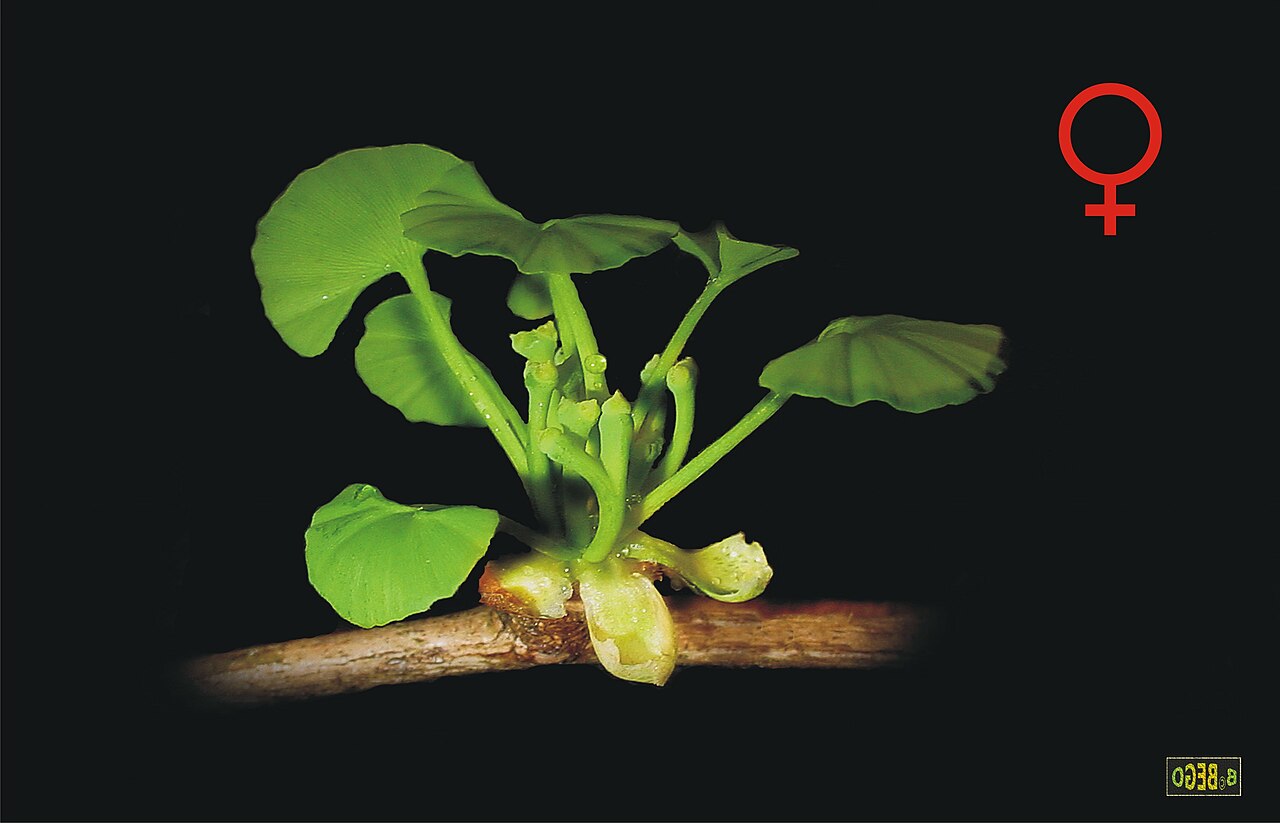 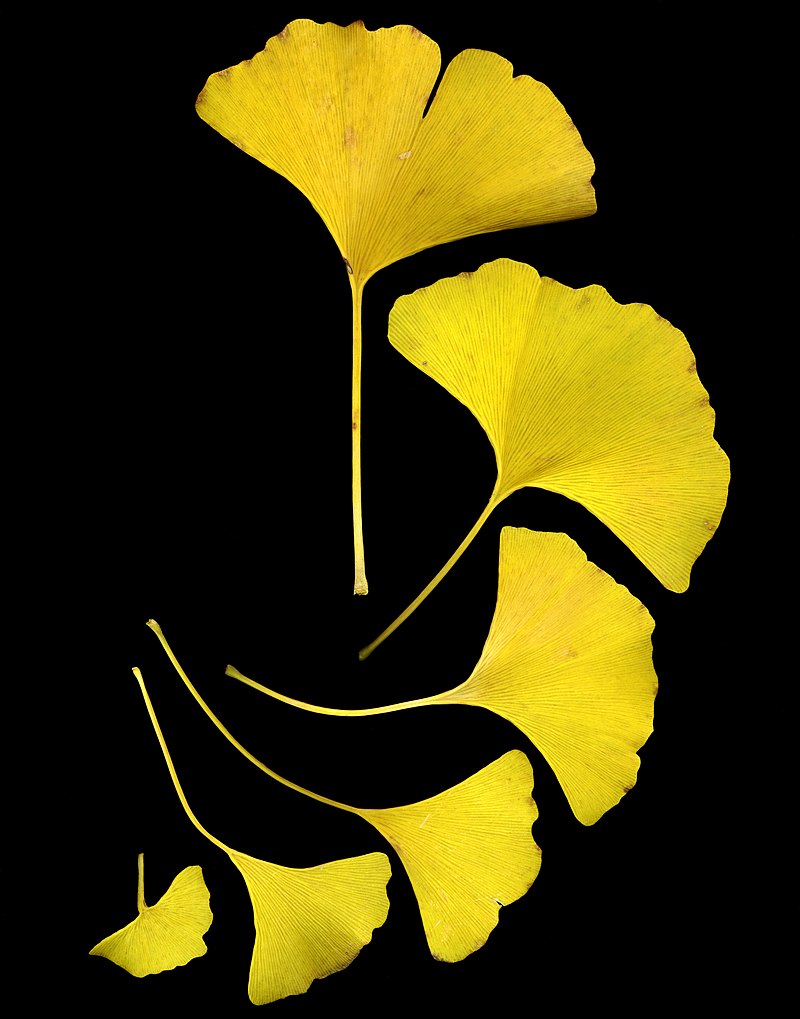 Exhibit B: Araucaria araucana (Monkey Puzzle Tree or Chilean Pine)Origin: Exhibit B: Araucaria araucana (Monkey Puzzle Tree or Chilean Pine)Origin: Native to central and southern Chile and western Argentina, it is the national tree of Chile. The recently found 'Wollemi pine', Wollemia, though discovered in south-east Australia, is possibly a relative. Their common ancestry dates to a time when Australia, Antarctica, and South America were linked by land as part of the supercontinent known as Gondwana. Features: It’s an evergreen tree growing to 1-1.5 m (3–5 ft) in diameter and 30–40 m (100–130 ft) in height. The leaves are thick, tough, and scale-like, and triangular with sharp edges and tips. The leaves persist for 10–15 years or more, covering most of the tree except for the older branches. The tree is usually dioecious, with the male and female cones on separate trees, though occasional individuals bear cones of both sexes. The cones disintegrate at maturity to release the 3–4 cm (1.2–1.6 in) long nut-like seeds. Fun Facts: - The origin of the popular English language name 'monkey puzzle' derives from its early cultivation in Britain in about 1850, when the species was still very rare in gardens and not widely known. Sir William Molesworth, the proud owner of a young specimen at Pencarrow Garden in Cornwall was showing it to a group of friends, when one of them, the noted barrister and Benthamist Charles Austin, remarked, "It would puzzle a monkey to climb that". As the species had no existing popular name, first 'monkey puzzler', then 'monkey puzzle' stuck.
- Its piñones, or seeds, are edible, similar to large pine nuts, and are harvested by indigenous peoples in Argentina and Chile, The tree has some potential to be a food crop in other areas in the future, thriving in climates with cool oceanic summers, e.g., western Scotland, where other nut crops do not grow well. A group of six female trees with one male for pollination could yield several thousand seeds per year, and since the cones drop, harvesting is easy. The tree, however, does not yield seeds until it is around 30 to 40 years old, which discourages investment in planting orchards. Once established, trees can live possibly as long as 1,000 years.
- The trees feature in the film, The Ghost and Mrs. Muir (1947), in the novel Charlotte Sometimes by Penelope Farmer, and in both of Harper Lee’s novels, To Kill a Mockingbird and Go Set a Watchman. The pseudonym "Araucaria" was used by a British crossword compiler for The Guardian newspaper, the Reverend John Galbraith Graham MBE (1921–2013), who also provided cryptic crosswords under the pseudonym Cinephile—an anagram of "Chile Pine" the tree's alternative name—in the Financial Times and puzzles for other publications.
    Exhibit C: Division Bryophyta (Moss) Exhibit C: Division Bryophyta (Moss)
Origin: The fossil record of moss is sparse, due to their soft-walled and fragile nature, but unambiguous moss fossils have been recovered from as early as the Permian period (298.9 to 252.17 million years ago) in Antarctica and Russia, and a case has been put forward for mosses during the Carboniferous period (358.9–298.9 million years ago). Mosses appear to evolve 2–3 times slower than ferns, gymnosperms and angiosperms. Recent research show that ancient moss could explain why the ice ages occurred. When the ancestors of today's moss started to spread on land 470 million years ago, they absorbed CO2 from the atmosphere and extracted minerals by secreting organic acids that dissolved the rocks they were growing on. These chemically altered rocks in turn reacted with the atmospheric CO2 and formed new carbonate rocks in the ocean through the weathering of calcium and magnesium ions from silicate rocks. The weathered rocks also released a lot of phosphorus and iron which ended up in the oceans, where it caused massive algal blooms, resulting in organic carbon burial, extracting more carbon dioxide from the atmosphere. Small organisms feeding on the nutrients created large areas without oxygen, which caused a mass extinction of marine species, while the levels of CO2 dropped all over the world, allowing the formation of ice caps on the poles. Features: Mosses are small flowerless plants that typically grow in dense green clumps or mats, often in damp or shady locations. The individual plants are usually composed of simple, one-cell thick leaves, attached to a stem that may be branched or unbranched and has only a limited role in conducting water and nutrients. Although some species have vascular tissue this is generally poorly developed and structurally different from similar tissue found in other plants. They do not have seeds and after fertilization develop sporophytes (unbranched stalks topped with single capsules containing spores). Fun Facts:
- Pre-industrial societies made myriad use of the mosses growing in their areas: Laplanders and other circumpolar people in North America used mosses for bedding, insulation in boots and mittens, food storage, wound dressing, diapers, and maxi pads. In rural the UK, Fontinalis antipyretica was traditionally used to extinguish fires as it could be found in substantial quantities in slow-moving rivers and the moss retained large volumes of water which helped extinguish the flames. This historical use is reflected in its specific Latin/Greek name, the approximate meaning of which is "against fire".
- Moss is often considered a weed in grass lawns, but is deliberately encouraged to grow under aesthetic principles exemplified by Japanese gardening. In old temple gardens, moss can carpet a forest scene. Moss is thought to add a sense of calm, age, and stillness to a garden scene. A passing fad for moss-collecting in the late 19th century led to the establishment of mosseries in many British and American gardens. The mossery is typically constructed out of slatted wood, with a flat roof, open to the north side (maintaining shade). Samples of moss were installed in the cracks between wood slats. The whole mossery would then be regularly moistened to maintain growth.
- Mosses are sometimes used in green roofs. Advantages of mosses over higher plants in green roofs include reduced weight loads, increased water absorption, no fertilizer requirements, and high drought tolerance. Since mosses do not have true roots, they require less planting medium than higher plants with extensive root systems. With proper species selection for the local climate, mosses in green roofs require no irrigation once established and are low maintenance.
- Decaying moss in the genus Sphagnum is also the major component of peat, which is "mined" for use as a fuel, as a horticultural soil additive, and in smoking malt in the production of Scotch whisky. The practice of harvesting peat moss should not be confused with the harvesting of moss peat. Peat moss can be harvested on a sustainable basis and managed so that regrowth is allowed, whereas the harvesting of moss peat is generally considered to cause significant environmental damage as the peat is stripped with little or no chance of recovery
- In World War I, Sphagnum mosses were used as first-aid dressings on soldiers' wounds, as these mosses were said to absorb liquids three times faster than cotton, retain liquids better, and are cooler, softer, and less irritating. It was also claimed that they had mild antibacterial properties.
   Up Next: Forum Faves & Requests, including Triffids, Lobelia dunbarii, Gentiana, Hydrangea, and Himalayan Blue Poppy... Up Next: Forum Faves & Requests, including Triffids, Lobelia dunbarii, Gentiana, Hydrangea, and Himalayan Blue Poppy...
|
|
|
|
Post by Lord Lucan on Apr 10, 2016 20:19:19 GMT -5
Peat moss is a component of peat, and what is moss peat, then? These are interesting, I though - peat gatherers at Westhay, Somerset Levels in 1905 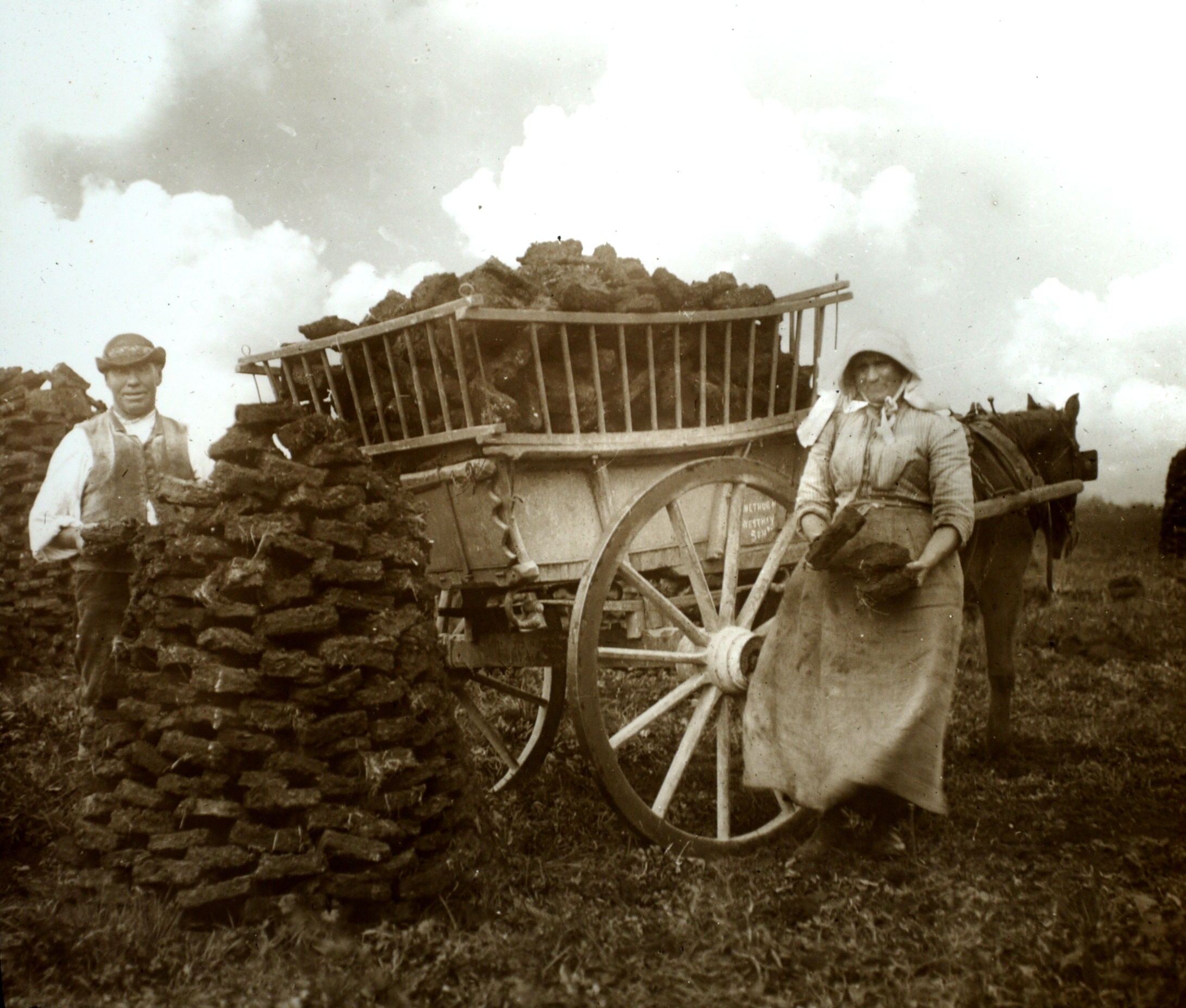   |
|























 skunk cabbage flower
skunk cabbage flower

























